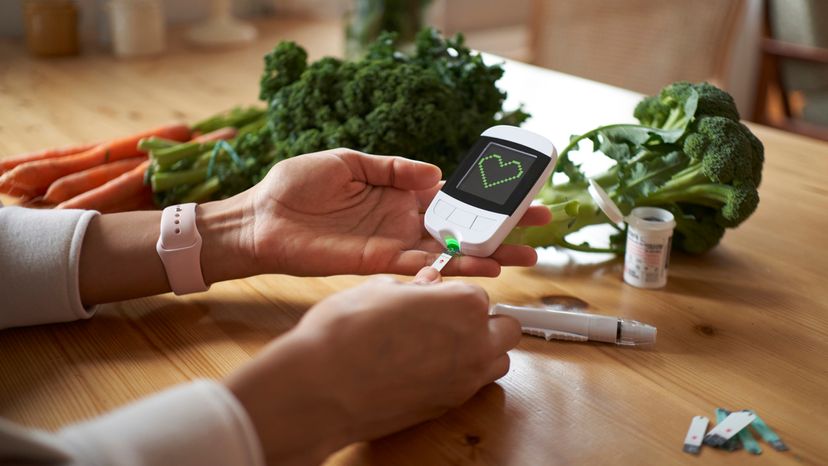
Each day in the United States, some 18 million people with diabetes walk a tightrope between too little sugar in the bloodstream and too much. Too little, which may come from a complication of medication, and they may quickly be overcome by dizziness, fatigue, headache, sweating, trembling, and, in severe cases, loss of consciousness and coma. Too much, which can happen after eating too much, especially if the person is older and overweight, and the person may experience weakness, fatigue, excessive thirst, labored breathing, and loss of consciousness.
If diabetes is poorly controlled or left untreated, it may lead to blindness, kidney disease, blood vessel damage, infection, heart disease, nerve damage, high blood pressure, stroke, limb amputation, and coma.
Advertisement
Because the initial symptoms (fatigue, weakness, frequent urination) are usually mild, about 30 percent of all people with diabetes do not realize that they have the disease. And that can have tragic consequences, because with early diagnosis and treatment, the chances of living a long and productive life are higher than if the disease creeps along until irreversible damage occurs.
If you'd like some proof that diabetes is a disease you can live well with, consider the accomplishments of these prolific people with diabetes: jazz musician Dizzy Gillespie, singer Ella Fitzgerald, actress Mary Tyler Moore, and baseball Hall-of-Famer Jim "Catfish" Hunter. Even before treatment was as sophisticated as it is today, author Ernest Hemingway and inventor Thomas Edison, both of whom had diabetes, managed to leave their marks on the world.
If you are one of the lucky ones whose diabetes has been diagnosed by a doctor, you probably have some idea of what has gone awry in your body. Basically, the disorder stems from a malfunction in the way your body processes carbohydrates from the food you eat.
Normally, the process goes like this: The carbohydrates from your food are converted into a form of sugar called glucose. Glucose is the preferred fuel for your body's cells, and it's the only food your brain can use. The glucose floats along in the bloodstream until the pancreas, a large gland located behind the stomach, goes into action. The pancreas produces insulin, a hormone that signals body cells to take in the glucose. Once inside the cell, the glucose is either used as fuel to produce heat or energy or is stored as fat.
In a person with diabetes, however, the pancreas either produces little or no insulin or the cells becomes resistant to the hormone's action. The result is that the glucose can't get into the cells; it accumulates in the blood and is later expelled in the urine. In short, blood sugar rises while cells starve.
Five to 10 percent of people with diabetes have type 1, or insulin-dependent, diabetes, which usually develops in childhood or young adulthood. People with type 1 diabetes require daily injections of insulin to keep their blood glucose levels under control.
The vast majority of people with diabetes, on the other hand, have the type 2 form, which is sometimes referred to as adult-onset diabetes, even though more and more children these days are developing this type. Lifestyle changes can play a vital role in controlling type 2; they are generally the initial and preferred method for regulating blood sugar levels, although oral medication and even insulin may eventually need to be added to the treatment regimen.
People with diabetes face health hurdles every single day. In this article, we'll look home remedies for diabetes, including food remedies for weight control and blood sugar levels, and home care for diabetic foot health.
For more information about diabetes and how to control the digestive disorders associated with this condition, try the following links:
- To see all of our home remedies and the conditions they treat, go to our main
- Bilberry, which can be used in pies, is also very effective in regulating blood sugar and managing diabetes. Learn more in Herbal Remedies for Diabetes.
- Find out how to manage your diabetes care and get the best results possible.
- When you read this straight-forward article, you'll understand how diabetes works.
- Read about how to adjust to life with diabetes, and get great ideas for lifestyle changes.
- Discover ways that you can control diabetes with exercise.
This information is solely for informational purposes. IT IS NOT INTENDED TO PROVIDE MEDICAL ADVICE. Neither the Editors of Consumer Guide (R), Publications International, Ltd., the author nor publisher take responsibility for any possible consequences from any treatment, procedure, exercise, dietary modification, action or application of medication which results from reading or following the information contained in this information. The publication of this information does not constitute the practice of medicine, and this information does not replace the advice of your physician or other health care provider. Before undertaking any course of treatment, the reader must seek the advice of their physician or other health care provider.
Advertisement


